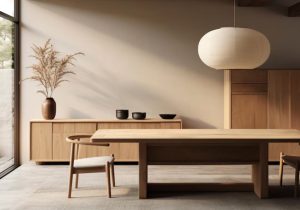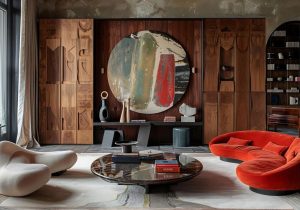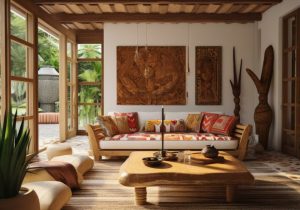Life is messy, let’s face it. That imperfectly chipped teacup that you just can’t seem to bring yourself to throw away, that worn rug in the living room that is still cozy under your feet despite all the wear-are all imperfections we are surrounded by, and that is okay, perfectly. There is even a whole philosophy that revels in these little flaws as a reminder that beauty just may be sitting right under our noses.
Living in a world that’s obsessed with perfection-think immaculate Instagram feeds and Pinterest-perfect homes-the ancient Japanese philosophy of Wabi-Sabi is a breath of fresh air. Wabi-Sabi is not about the impossible chase for perfection but, rather, an appreciation of what is real, what is lived in, and what is authentic. It’s the beauty of finding grace in imperfect, impermanent, and incomplete things. And isn’t that just what we all need in today’s fast-paced, crazy-stressful world?
Bring that philosophy into your home-now a space where every crack, wrinkle, and worn edge is not something to hide but rather to be celebrated. The home tells a story with its imperfections, creating an atmosphere that is calm, centered, and yours alone. This, essentially, is what Wabi-Sabi interior design is all about.
Through this blog, we are going to show you how to bring Wabi-Sabi into your home in order to make it not only beautiful but also meaningful. We shall look at what the main principles of Wabi-Sabi are, how to use natural materials and earthy tones, and why simplicity is going to be your best friend. Ready to fall in love with the art of imperfection? Then let’s start.

The concept of Wabi-Sabi is more of a way of life than an aesthetic. This Japanese philosophy teaches us to find beauty in the transitory and imperfect things that make life. The term itself is a combination of two words: “Wabi” refers to rustic simplicity and quietness, while “Sabi” means taking pleasure in things that are imperfect, aged, and weathered.
Wabi-Sabi, in simple interior design parlance, is about creating spaces that are authentic and rather lived-in than polished and perfect. It’s all about appreciation for the beauty of natural materials, the charm of handmade objects, and well-the character brought about by age and use. In a Wabi-Sabi home, every object has a purpose, and every flaw tells a story
Embrace Simplicity: Wabi-Sabi invites one to strip away the unnecessary and concentrate on what genuinely counts. That does not mean one should live in an empty, minimalistic space but rather create a conscious home. Wabi-Sabi is the beauty of the unique and the imperfect, from a crack in a ceramic bowl to the grain on a wood table. Appreciate the natural: Wabi-Sabi design is all about natural materials such as wood, stone, and clay. In fact, it’s these materials that will age gracefully over time, adding a little depth and character to your home.

Of course, bringing Wabi-Sabi into your home does not imply that you must renovate everything in it or replace your decor with new items. It’s more about making conscious decisions to embrace the imperfect, the simple, and the natural beauty that may already exist in your home. Wabi-Sabi thus seems an inherent continuation in Indian homes where tradition and a deep rooted relation with nature become part of daily life.
Let’s see how you can introduce this philosophy into your Indian home, creating and residing in a serene, soulful home.

Start with What You Have: Perhaps one of the easiest ways to begin a process with Wabi-Sabi is to learn an appreciation for what one owns. That old wood chair, the edges worn? It’s a perfect example of Wabi-Sabi. That small crack in the wall that you mean to fix? Maybe this adds character to the room, telling something about the history of the home.
Instead of hiding or replacing these imperfections, celebrate them. In a Wabi-Sabi home, each flaw is celebrated-a feature, each crack a talk starter. Take a look around your home for items that have grown old beautifully with time. These will be pieces that add authenticity to your space-time that has passed, reflected by life lived between those walls.
Incorporating Handmade or Vintage Items: Wabi-Sabi values the handmade over the mass-produced, the unique piece over the cookie-cutter. One of the best ways to implement that philosophy is by bringing handmade or vintage items into your home. Think of handmade pottery with its irregular edges, perhaps a vintage rug whose color tones have been faded with time, or handwoven textiles bearing the signature marks of those who made it.
Traditional crafts such as hand-painted ceramics, handwoven dhurries, and brass ware bring in that perfect Wabi-Sabi touch to Indian homes. These things are not just a beauty to behold, but they also carry the stories of the artisans who made these pieces, adding depth and meaning to your home.

Curate with intent: The idea is that everything in the Wabi-Sabi home is there for a reason, and every decoration has meaning. It’s not about filling a space but about curating objects that speak to you. This can be as simple as a hand-thrown ceramic vase, an art piece speaking to your soul, or even a simple wood bench to sit and place treasured items upon.
In Wabi-Sabi, simplicity is not stark minimalism; it is about creating openness, calmness, and space without clutter. This could be letting go of items that do not add value to life or the arrangement of furniture to create flow in balance. Of course, homes are where life gets pretty full-on in India, so a space like this, formed out of simplicity, can be a retreat.
Finding Serenity in Chaos: Life is chaotic, and that chaos often spills into our homes. But amidst the philosophy of Wabi-Sabi lies a quiet calm-a calm born from embracing chaos rather than fighting it. That may mean not sealing the crack in the wall, not obsessing over a perfectly set table, or letting books gather dust in the corner. It’s about finding balance amidst the messy reality of life, allowing the home to reflect life as it is truly lived, not as it should be.

Bringing the Outside In: Perhaps one of the easiest ways to bring Wabi-Sabi into your home is by bringing the outdoors inside. That could be as simple as having a nosegay of wildflowers, smooth stones collected from the river, or a little indoor garden. These things remind us about the seasons of natural growth and decay and thus offer a layer of tranquility in our living spaces.
This would mean placing a tulsi by the window, displaying handwoven baskets on a shelf, or using clay pots for cooking in Indian homes. This nature is intrinsically grounding and brings balance and harmony into your home.
Wabi-Sabi Home-a house in which one could sit in stillness and quiet contemplation. Maybe it is a corner with a comfortable chair, a simple altar with meaningful items, or by the window to watch the world go by. They do not have to be elaborate-just a moment of stillness throughout the day.
These reflective homes can indeed be very enriching to create in Indian culture, where the aspect of spirituality is so much woven into everyday existence. Whether it is a little nook to say one’s prayers, a corner for meditation, or just a place where one can sit and be still, these are places of connecting with yourself and the world around you.
In a world that constantly goes overboard chasing perfection, Wabi-sabi is the ability to slow down, go to the beauty of imperfection, and create our homes with a true reflection of ourselves. Put Wabi-Sabi into your interior design, and you’ll create not just a beautiful space but one that is authentic, tranquil, and with profound meaning.
At Bonito Designs, we believe in crafting your home to be more than just a place to live-it’s a sanctuary that tells your story. Our expert designers will work with you to craft spaces that highlight the beauty of imperfections through the use of natural materials, simple designs, and a thoughtful layout to create a home that will feel truly yours.
Bonito Designs offers tailor-made solutions in sync with your own personal taste and value sets. Be it sourcing that perfect handmade piece or presenting layouts that bring in a naturalistic flow and balance, we are here to help you celebrate imperfection.
Let’s design a home, in all its imperfections, as perfect as life.
Wabi-Sabi is a Japanese philosophy that celebrates beauty in imperfection, simplicity, and natural aging of objects, turning a residence into a haven that exudes serenity and authenticity.
Let the imperfections shine; appreciate the beauty of natural materials, choose items with character and story, and show them in your curated space with a handmade or vintage flair. Get in touch with Bonito Designs for a well-curated, and personalised home interiors designed exclusively by the foremost celebrities.
While both philosophies celebrate simplicity, Wabi-Sabi is more about discovering beauty in imperfection and natural aging rather than mere de-cluttering.
Wabi-Sabi generally uses natural materials like wood, stone, clay, and organic textiles, which age well and add warmth and texture to a space.
Bonito Designs offers custom design services layered with Wabi-Sabi, which starts from using natural materials to create well-thought-out and authentic layouts—celebrating the beauty of imperfection.